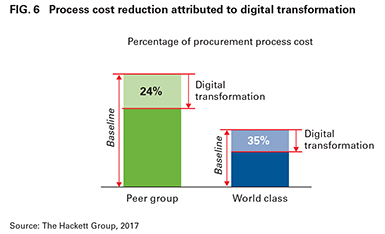Typical procurement organizations can substantially narrow the gap between their cost levels and that of top performers, and top performers can become even better by leveraging digital transformation, according to new world-class procurement research from The Hackett Group, Inc.
World-class procurement organizations now operate at 22 percent lower labor costs than their peers, and have 29 percent fewer staff, while demonstrating improved effectiveness and better performance across a wide array of key metrics, The Hackett Group's research also found.
For a typical company with $10 billion in revenue, attaining world-class performance in procurement can represent as much as $6 million in potential annual functional cost savings. World-class procurement organizations also generate more than twice the ROI of typical procurement organizations, generating more than $10 in savings for every $1 of procurement operating cost.
 The potential cost take-out opportunity through digital transformation of the procurement function is dramatic, the research found. Typical procurement organizations can reduce procurement process costs by up to 24 percent by implementing robotic process automation, advanced analytics, cloud-based applications and other digital transformation approaches. World-class procurement organizations can reap process cost savings of 35 percent through digital transformation (see chart, available here or on BusinessWire).
The potential cost take-out opportunity through digital transformation of the procurement function is dramatic, the research found. Typical procurement organizations can reduce procurement process costs by up to 24 percent by implementing robotic process automation, advanced analytics, cloud-based applications and other digital transformation approaches. World-class procurement organizations can reap process cost savings of 35 percent through digital transformation (see chart, available here or on BusinessWire).
A public version of the research, “Raising the World-Class Bar in Procurement Through Digital Transformation,” is available on a complimentary basis, with registration, at this link: http://bit.ly/2tkByQc
The research also found that in addition to reduced cost and fewer staff, world-class procurement organizations are significantly more effective than their peers in how they operate and deliver services. Transactions require discrepancy resolution two to three times less often. Annual procurement staff turnover is also 45 percent lower, a sign that staff are being given opportunities for professional growth.
The Hackett Group's research details six digital accelerators for improving procurement's performance and supporting business strategy over the long term, including: digital tools to enhance customer engagement; robotic process automation to perform rules-based activities; the use of big data and advanced analytics to drive insight and bolster decision making; cloud-based applications; digital workforce enablement to maximize productivity; and cognitive computing to simulate human thought and augment the ability of procurement to run models, make predictions, and analyze large data sets.
Christopher S. Sawchuk, a principal & global procurement advisory practice leader for The Hackett Group, told SCMR in an interview that resistance to change in government procurement practices “is a given,” but that private enterprises are also lagging too.
“Technology has always played an important role in enabling performance, but procurement has reached an inflection point,” he said. “World-class can continue to reduce costs by embracing digital technology, and typical procurement organizations can leverage the same technology to catch up faster at less cost.”
Sawchuk added that digital business tools today are converging with employees and consumers who are increasingly comfortable with new mobile technologies and business models.
“This has created tremendous opportunities for procurement organizations to transform service delivery, reduce errors, make information easier to access, and even deliver a whole new class of services.”
Sawchuk concluded by telling SCMR that “we have to become more predictive and agile”
According to Robert Derocher, a principal at The Hackett Group, “Cloud-based software tools in particular are emerging as strong enablers of procurement activities. Supplier discover software, for example, can reduce the time it takes to find and qualify suppliers by over 30 percent. E-sourcing software can cut overall cycle time by 30 percent, with standard templates reducing data collection errors. Contract lifecycle management software can also cut the time required to find a contract nearly in half, and trim the number of lapsed contracts by nearly 40 percent.
“Technology alone will not deliver results,” said Derocher. “It must fit within a larger strategy, one based on a well-designed service delivery model that looks at not just technology, but also processes, information, talent and organizational redesign. But the promise of digital, in the context of a well-rounded transformation effort, is tremendous.”
The Hackett Group's procurement research is based on an annually updated analysis of results from recent benchmarks, performance studies, and advisory and transformation engagements at hundreds of large global companies.
SC
MR


Latest Supply Chain News
- Tech investments bring revenue increases, survey finds
- Survey reveals strategies for addressing supply chain, logistics labor shortages
- Israel, Ukraine aid package to increase pressure on aerospace and defense supply chains
- How CPG brands can deliver on supplier diversity promises
- How S&OP provides the answer to in-demand products
- More News
Latest Resources

 Explore
Explore
Procurement & Sourcing News
- Israel, Ukraine aid package to increase pressure on aerospace and defense supply chains
- How CPG brands can deliver on supplier diversity promises
- How S&OP provides the answer to in-demand products
- There is still work to do to achieve supply chain stability
- Blooming success: The vital role of S&OE in nurturing global supply chains
- How one small part held up shipments of thousands of autos
- More Procurement & Sourcing
Latest Procurement & Sourcing Resources

Subscribe

Supply Chain Management Review delivers the best industry content.

Editors’ Picks





